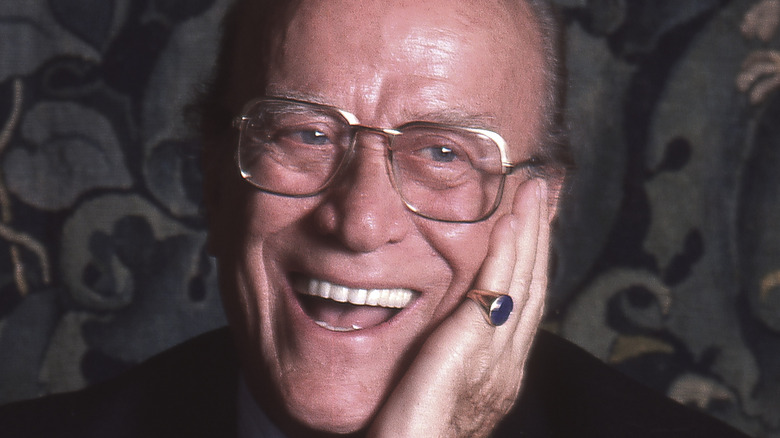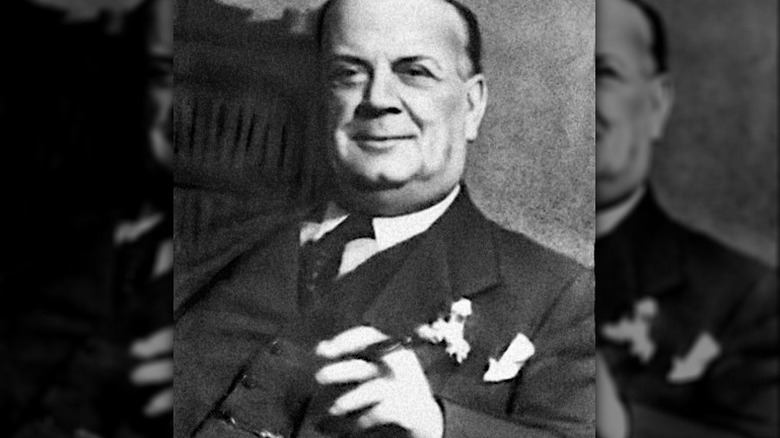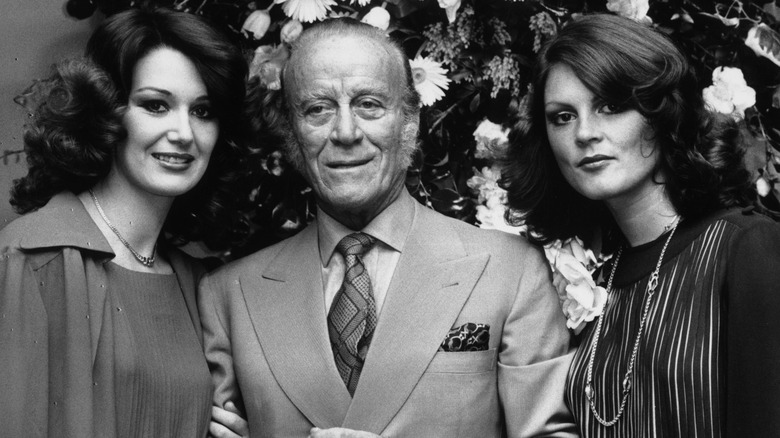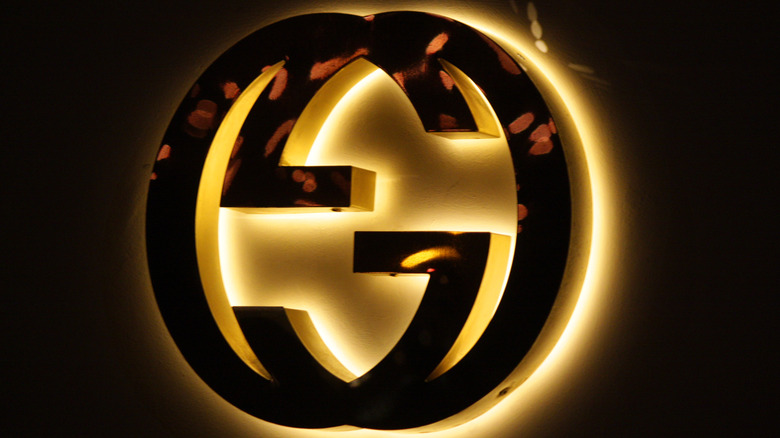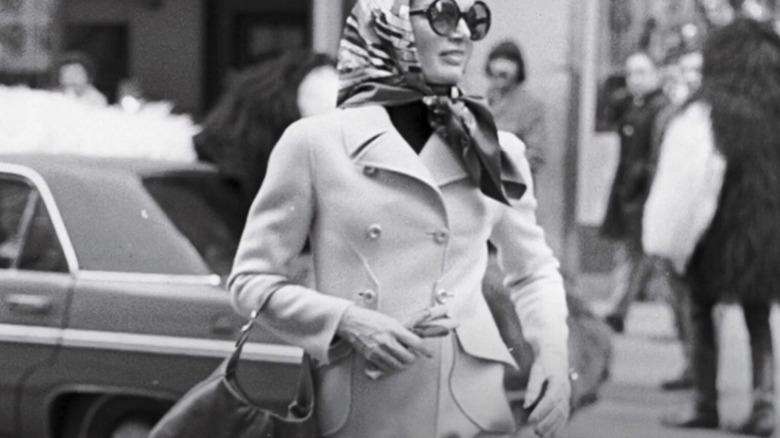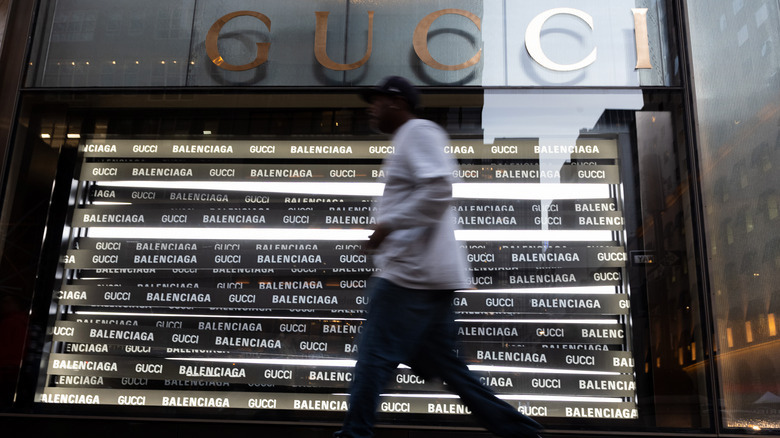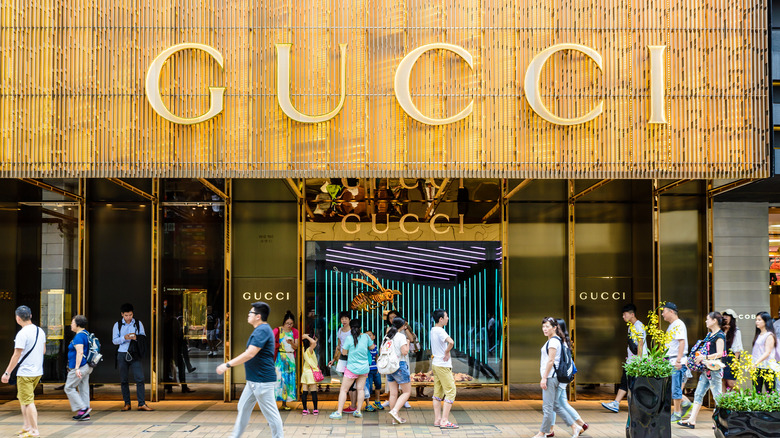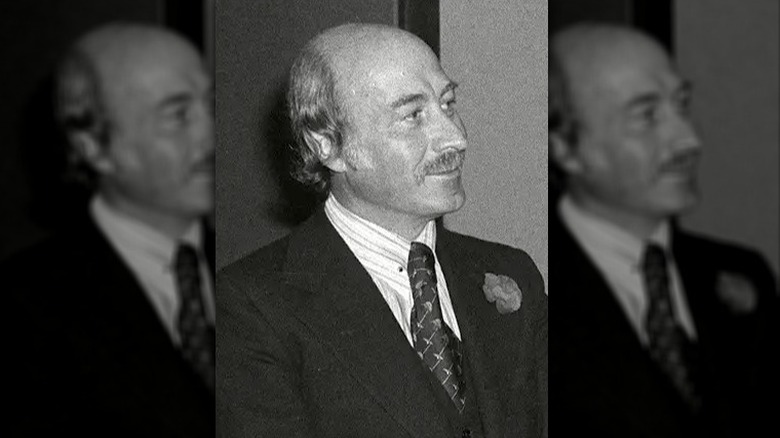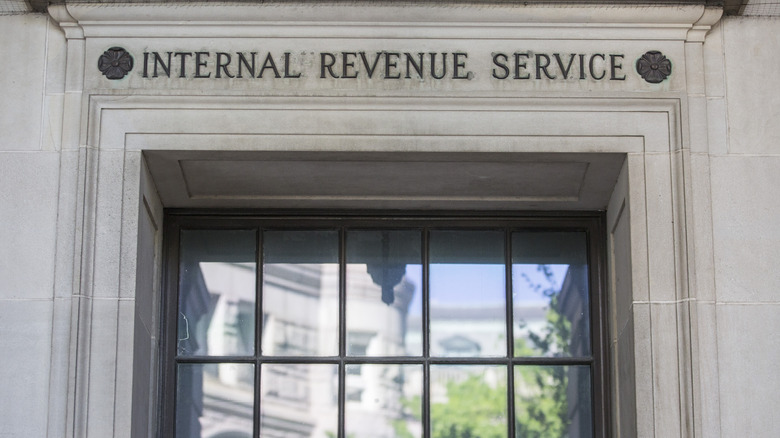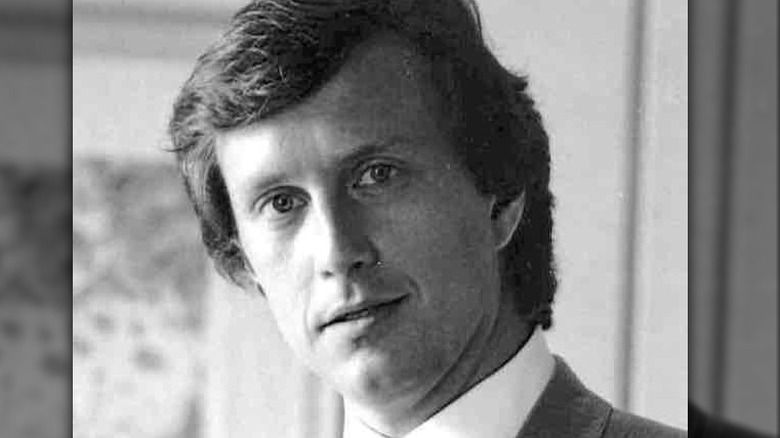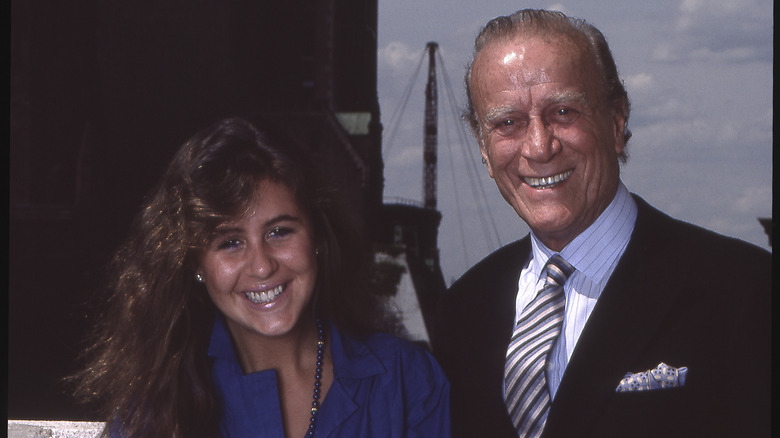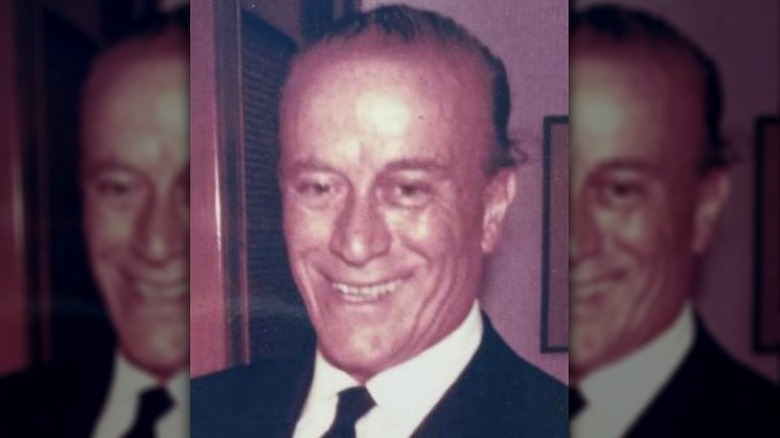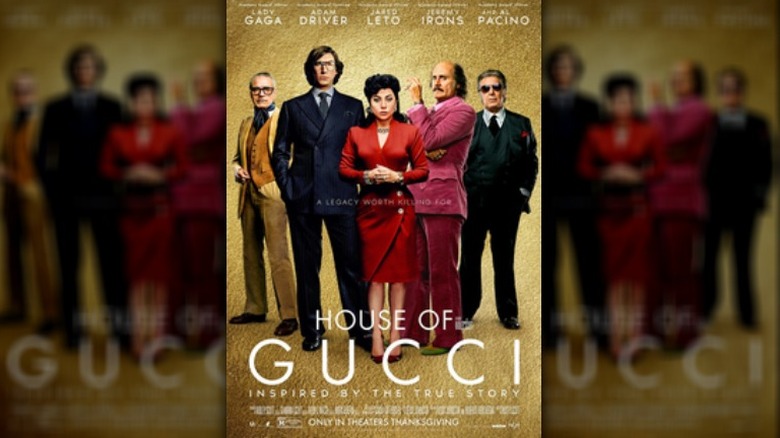The Untold Truth Of Aldo Gucci
We may receive a commission on purchases made from links.
Today, Gucci may be known for its status as a global luxury brand, but it was born out of the humble beginnings of a young man named Guccio Gucci, who was looking for a little adventure, but mostly a better life. At the end of the 19th century, still a teenager, Guccio left his home in Florence, Italy looking for any work he could get in England at the luxurious London Savoy Hotel. First, he was a dishwasher and then a bellboy, sometimes picking up shifts at the hotel concierge desk. He was immediately captivated by the lifestyles of the rich and famous guests of Europe's premier hotel, according to the Independent. As the luggage handler, Guccio took special note of the suitcases and travel bags of the wealthy arrivers. Luxury leather luggage produced by London's H.J. Cave & Sons were among his favorites.
Within a few years, Guccio returned home to Florence, married 24-year-old dressmaker Aida Calvelli, and took his savings from working abroad to found his saddlery company, Gucci, in 1906. But by 1921, he realized his opportunities would be greater if he began producing a broader range of artisan leather goods for wealthy clients, including luggage, wallets, and other accessories, per InStyle. That shift is what set Gucci on the course to become the brand it is today — a shift that Guccio's oldest son, Aldo, is credited with realizing through his workhorse ways, shrewd business acumen, a touch of marketing genius, and some serious drama.
Aldo took an interest in Gucci early in life
Aldo Gucci was born in 1905, the oldest son of Guccio (pictured above) and Aida, although she already had a son from a previous relationship, and the couple had an older daughter, Grimalda. But Aldo was Guccio's oldest son, a position in the family that would later shape how he approached the family business and how he managed relationships among his siblings and their children with a patriarchal flair. Later came two brothers: Vasco in 1907 and Rodolfo in 1912. Another brother, Enzo, died in childhood.
Aldo was a teenager, Guccio gave him a taste of the family business. After school, Aldo would visit the workshop, watching the artisan workers cut, shape, and stitch the fine Italian leather Gucci was developing a reputation for producing. Guccio would give young Aldo small tasks like sweeping the workroom after the crew had gone home, according to Sara Gay Forden's "The House of Gucci: A True Story of Murder, Madness, Glamour, and Greed." On other occasions, Guccio would send Aldo on deliveries to local hotels and personal clients, which gave him immense satisfaction when he saw faces light up as he handed over parcels of Gucci products.
Aldo Gucci's charisma was a company asset
When Guccio realized that Aldo had a charismatic way with his delivery customers, he moved his son to the front of the house, giving him some merchandising tasks, as well as face time with customers in the shop. That often meant Guccio had to look the other way when the tall, handsome, and blue–eyed Aldo would go overboard with his flirtations among the young female clientele as he tried to sell them on the best Gucci had to offer. However, Guccio could turn the other way no longer when, per Brides, Princess Elisabeth of Romania visited the shop one day to say that Aldo had been seeing one of her servants, Olwen Price, a dressmaker from the English countryside. She requested that Guccio intervene, or she would have to send Price home.
Aldo told his father and Princess Elisabeth that he intended to marry Olwen, leaving out the detail that she was already pregnant. The two married at a church near Olwen's family in England on August 22, 1927. But what was once a thrilling affair soon turned into an unhappy marriage. The couple had three boys — Giorgio, Paolo, and Roberto — but Olwen retreated, while Aldo went full force into the business. "Aldo loved life, but she put a damper on anything he wanted to do," Grimalda Gucci later told Forden in "House of Gucci."
The famous Gucci 'Double-Gs' were Aldo's design
Although Aldo Gucci began working at Gucci full time when he was 20 years old, he earned a doctorate degree in economics from the University of Florence, per the Sun Sentinel. In the mind of his father, it was training to back up his innate business instincts. When Guccio Gucci originally launched his business in the early 1920s, his logo was a reflection of what inspired him to get into the Italian leather goods trade in the first place. According to Elle, a bellboy carrying luggage under one arm and a travel bag under the other was a callback to his time as a bellboy. But when Gucci opened a shop, his sons Rodolfo, Vasco, and (especially) Aldo didn't see the bellboy emblem as a sign of luxury. They set out to develop a new logo and came up with a version of the Gucci family crest that featured a knight carrying luggage, per Fabrik.
However, Aldo still wasn't satisfied, and within a couple of years took the logo in a completely different direction by focusing on the legacy of the brand: his father's initials. According to Editorialist, Aldo's new logo was released in 1933 and became instantly recognizable — so much so, the company has stuck with the double-G logo ever since. There have been refinements and alterations over the years, but Aldo Gucci's interlocking Gs — and their repeat pattern — have remained an iconic staple of global fashion for nearly a century.
Aldo made the Gucci name known around the world
Perhaps better than anybody in the Gucci family, Aldo Gucci understood the importance of meeting exclusive clients where they were. Instead of waiting for customers to come to their shop in Florence, they would open in Rome in 1939, and then Milan a full decade later, per Vogue. Each of the expansion stores within Italy were meant as a test by Aldo to prove to a reluctant Guccio that the Gucci brand should expand beyond Italy's borders. As if Aldo needed additional proof, by the 1950s, international movie stars — including Bette Davis, Katharine Hepburn, and Sophie Loren — had begun carrying Gucci bags, per Vogue. And Princess Elizabeth (just before her coronation), Eleanor Roosevelt, and Jacqueline Bouvier (before she married John F. Kennedy) all visited the original Gucci shop in Florence.
With success in each of the Italian stores and a steady stream of American and British elites visiting their shops, Aldo once again approached his father about taking their business across the sea, specifically New York City. This time, Guccio's reply was full of his stubborn nature, but also acknowledged that Aldo was likely onto something. "Risk your neck if you must, but don't expect me to pay for it," he said, according to Sara Forden's "The House of Gucci." "You may be right. After all, I am an old man. ... I'm old fashioned enough to believe that the best vegetables come from your own garden."
Gucci lands in New York
Aldo Gucci heard everything he needed to hear from his father and booked his flight from Florence to New York City — a junket that, in 1952, took 20 hours and included five stops across four countries. Still, nothing could deter Aldo from moving the Gucci brand forward by landing on what he saw as the choicest of luxury real estate: Fifth Avenue in Manhattan. Within months, Aldo returned to New York with his brothers Rodolfo and Vasco, eventually securing a small shop at 7 East 58th Street, just off Fifth Avenue. It was located in the Savoy Plaza Hotel, per Women's Wear Daily, which was also a nod to Guccio conquering his humble start as a bellboy at the Savoy Hotel in London.
Although Guccio was, per The New York Times, furious that the three brothers had taken a space without his final approval, Aldo managed to convince him to visit their new tony base in the U.S. Guccio was thrilled with the development and even tried to pass the idea off as his own, according to Forden's "The House of Gucci." But his joy was short-lived. Within days of Gucci opening on 58th Street, Guccio died unexpectedly from a heart attack in Milan, per Fashion Elite. He left the budding Gucci company in equal parts to his three sons, which paved the way for Gucci to become a global powerhouse. It also created decades of family power struggles of epic proportions.
Aldo led Gucci's international expansion
Now, with Rodolfo running operations in Milan and Vasco tending to the workshop and store in Florence, Aldo fully settled into New York City life and looked for more international opportunities. Before long, Aldo opened Gucci stores in Beverly Hills, Palm Beach, Paris, Tokyo, Hong Kong, and beyond. President John F. Kennedy dubbed Aldo Gucci "the first Italian ambassador of fashion," per the Robb Report. With an expansion of stores and boutiques came the need and opportunity to extend the Gucci offerings beyond bags and accessories. In 1972, a store solely dedicated to a new line of Gucci clothing opened at 699 Fifth Avenue, while the store at 689 Fifth Avenue remained focused on luggage, bags, shoes, and accessories.
The new growth in space and products required bringing more family members into the fold, something that was a point of pride for Aldo Gucci. "The one thing you should know about Gucci is that everything is done in the family," he told The New York Times in 1970. "We're like a trattoria, where everybody in the family is in the business. One day Valentino [the Roman couturier] said to me in Rome, 'Listen, Aldo, who is your designer? You must have somebody.' I told him the story about the trattoria, and he didn't believe me." Gucci added: "We do have affectionate fights, the kind that end with a kiss."
The Gucci family war begins
As Gucci expanded, both geographically and in its offerings, Aldo Gucci sought to bring more family members into operating the business. It became especially true after Aldo and Rodolfo's brother Vasco died in 1974, leaving the company split between the two surviving brothers. From the standpoint of Aldo and his sons, Rodolfo was not doing 50% of the work, and they became resentful of the split profit share, according to Forden's "The House of Gucci." Aldo attempted to solve that problem, per ABC News, by launching a Gucci perfume subsidiary, setting aside nearly all of the profits for himself and his sons, which started a family war and a struggle for power within the Gucci empire.
In the late 1970s, Aldo named his middle son, Paolo, vice president after years as chief designer of Gucci. But by 1980, when Paolo felt his voice wasn't being heard, he secretly tried to launch his own fashion line after consulting neither his father nor his uncle. They were infuriated and fired Paolo immediately. The company then sued Paolo for infringing on Gucci trademarks. The two elders also made it clear to all suppliers that they would be cut off from Gucci business if they dealt with Paolo. "I wanted to expand," Paolo later told People, "to bring in other financial backers and make the business run on more modern lines. But the Guccis have medieval concepts of business. So I became the black sheep."
Aldo Gucci landed in prison thanks to his son
In 1982, during a board meeting in Florence, Paolo, who still had a 3.3% stake in the company, claimed he was assaulted and left the meeting bleeding after he announced he intended to record the sessions. Just days later, Paolo filed a $13 million lawsuit in New York, asserting that he was beaten by his two brothers and cousin, Maurizio, who were instigated by his father, Aldo, according to Bustle. For his part, Aldo said [via People] that Paolo "likes to exaggerate," but did not deny that there was no violence at the board meeting. "Who is the father ... who has never given a slap to a reckless son?"
Following a few years of undermining one another, psychological warfare, and more lawsuits, Paolo sought his revenge by tipping off the IRS to the idea that his father was evading taxes, per Vulture. Millions of dollars in personal income had not been reported to the government. Aldo, who was in his 80s, ended up being sentenced to a year and a day in prison in 1986 for failing to pay $7 million in personal income tax, telling the court (via The New York Times), '"I forgive [Paolo], and I forgive anyone who wanted me to be here today."
Aldo loses control of Gucci
When Aldo and Rodolfo became equal owners of Gucci after the death of their brother Vasco 1974, Aldo took 10% of his half and split it equally among his three sons. It was a move to bring his sons into the fold and to provide an incentive to move the business forward. But it also made Rodolfo the majority stakeholder in Gucci. From Aldo's standpoint, that wasn't a problem. He would remain in control of the company as long as Rodolfo was alive. But that all changed when Rodolfo died in 1983 and his only son, Maurizio (pictured above), who had been trained by Aldo in New York, became majority owner with a 50% stake in the company.
In 1985, Maurizio booted Aldo as chairman, and persuaded the other board members to vote him in the position. "I know only that a board of directors elected me," Maurizio told The New York Times, adding, "It would be difficult to be in this chair if Aldo didn't want it." Maurizio soon realized the only way he would have true control of Gucci is if he could find an investor to buy out his relatives. He turned to Nemir Kirdar and his Bahrain-based Investcorp. Aldo was the last holdout, who finally sold his shares in 1989. He continued to work as a consultant to Gucci, but selling his shares ended his 65 years working for the company his father built.
Aldo Gucci had a (semi) secret family
Aldo Gucci and his wife, Olwen, were equally unhappy in their marriage. With divorce still illegal in Italy at the time, remaining together — at least formally — was the only option. But Aldo looked elsewhere for romance. Notably, that was in 1956, at work, with a 20-year-old Gucci store employee named Bruna Palombo, per the New York Post. Palombo quickly went from being in the shop to Aldo's personal assistant. He would fly Bruna to Paris for romantic weekend getaways, lavish her with jewelry and furs, and set her up with a nice home in Italy.
However, the semi-open secret love affair between Aldo and Bruna grew more intense when Bruna became pregnant. In 1963, Bruna delivered Patricia, who she was forced to keep a secret for the first year of her life, according to Harper's Bazaar. Aldo hired a nanny to take the infant on strolls so as to not draw any questions from neighbors. Before long, he based his operations out of New York, setting up an apartment for him, Bruna, and young Patricia in Manhattan. At social gatherings, Aldo began referring to her as "Mrs. Gucci." Patricia didn't even know her father had another family until she was 10 years old. "Our family was solid as a rock in my eyes," Patricia (pictured above with Aldo) told Harper's Bazaar. "[H]e was just my father. I never once questioned anything." In 1981, Aldo married Bruna in the U.S., never divorcing Olwen in Italy.
Aldo Gucci dies at 84
After Aldo Gucci resigned as head of Gucci America in 1984, the company undertook an internal audit at the direction of newly-appointed CEO Domenico De Sole. In 1988, Gucci America reported that under Aldo's management, the company had cheated the U.S. government out of corporate taxes between 1972 and 1982, UPI reported at the time. The company reached a deal with the IRS to pay $20.5 million in back taxes, penalties, and interest. A lawyer for Gucci America told a judge that the company had solicited false invoices from foreign corporations for services that had never been completed as a means to divert money to Aldo Gucci. He reportedly kept some of the cash for himself and gave the rest to members of the family.
As the most recent Gucci financial drama came to a close, Aldo's health severely declined. Aldo Gucci died following a battle with prostate cancer on January 19, 1990, at the Flaminia clinic in Rome, according to his obituary in The New York Times. He was 84. Despite all of the family feuds, Aldo Gucci was entombed at the family mausoleum in Florence. Still, his nephew, Maurizio Gucci, who had become the head of the Gucci fashion house, could find few words about his uncle outside of their business relationship, saying in a statement, "Aldo Gucci was a man of great vision. His efforts were instrumental in establishing Gucci as the premier name in luxury leather goods in the United States."
The Gucci family didn't like how 'House of Gucci' portrayed Aldo
In 2021, MGM and United Artists released Ridley Scott's "House of Gucci," a dramatic Italian fashion family soap opera that focuses on the tumultuous relationship between Gucci heir Maurizio Gucci, portrayed by Adam Driver, and his wife, Patrizia Reggiani, played by Lady Gaga. Based on Sara Gay Forden's 2001 book, "The House of Gucci: A Sensational Story of Murder, Madness, Glamour, and Greed," Scott covers the 25 years of the couple's history together from their first meeting to Reggiani's hired assassination of Maurizio. It simultaneously portrays an extended Machiavellian family that spends decades betraying one another to only come together again, if for no other reason than personal gain.
Audiences seemed to have been more enthralled with the film than critics, per Rotten Tomatoes, but the Gucci family should not be included among them. "We are truly disappointed. I speak on behalf of the family,” Patrizia Gucci told The Associated Press. "They are stealing the identity of a family to make a profit, to increase the income of the Hollywood system. ... Our family has an identity, privacy." In particular, Patrizia took issue with the portrayal of her grandfather, Aldo, by Al Pacino. "My grandfather was a very handsome man, like all the Guccis, and very tall, blue eyes and very elegant." She drew a sharp distinction to Pacino, calling him "short, with sideburns, really ugly," adding that it was "shameful, because he doesn't resemble him at all."
